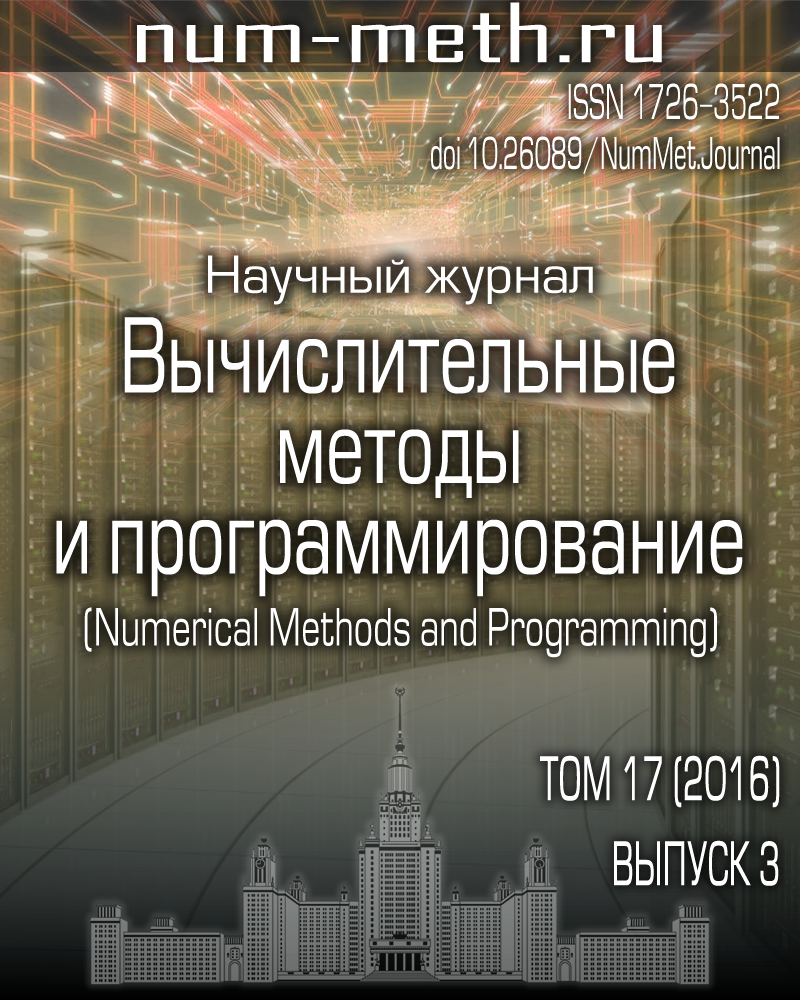DOI: https://doi.org/10.26089/NumMet.v17r326
Некоторые задачи управления и обратные задачи для линейных параболических уравнений
Ключевые слова:
Аннотация
На основе принципа двойственности исследованы свойства решений задач управления и обратных задач для одномерных параболических уравнений. Такой подход позволяет обобщить для линейных параболических операторов с коэффициентами, зависящими от (x,t), известный результат Лионса о плотности усредненных наблюдений в задачах управления с управляющим воздействием в начальном условии. Показано, что значение этих свойств плотности не ограничивается задачами управления. Рассмотрено использование таких свойств при изучении обратных параболических задач, в том числе при исследовании условий единственности их решения.
Загрузки
Опубликован
Выпуск
Раздел
Библиографические ссылки
- O. A. Ladyzhenskaya, V. A. Solonnikov, and N. N. Ural’tseva, Linear and Quasilinear Equations of Parabolic Type (Nauka, Moscow, 1967; SIAM, Providence, 1968).
- R. Lattés and J.-L. Lions, The Method of Quasi-Reversibility: Application to Partial Differential Equations (Elsevier, New York, 1969; Mir, Moscow, 1970).
- J.-L. Lions, Optimal Control of Systems Described by Partial Differential Equations (Springer, Heidelberg, 1971; Mir, Moscow, 1972).
- M. Lees and M. H. Protter, “Unique Continuation for Parabolic Differential Equations and Inequalities,” Duke Math. J. 28 (3), 369-382 (1961).
- A. Friedman, Partial Differential Equations of Parabolic Type (Prentice Hall, Englewood Cliffs, 1964; Mir, Moscow, 1968).
- M. V. Klibanov, “On a Class of Inverse Problems for Nonlinear Parabolic Equations,” Dokl. Akad. Nauk SSSR 280 (3), 533-536 (1985) [Sov. Math. Dokl. 31, 104-107 (1985)].
- A. I. Prilepko and V. V. Solov’ev, “Solvability Theorems and Rothe Method in Inverse Problems for Equations of Parabolic Type,” Differ. Uravn. 23 (11), 1971-1980 (1987) [Differ. Equ. 23 (11), 1341-1349 (1987)].
- V. Isakov, “Inverse Parabolic Problems with the Final Overdetermination,” Comm. Pure Appl. Math. 44 (2), 185-209 (1991).
- A. B. Kostin, “The Inverse Problem of Recovering the Source in a Parabolic Equation under a Condition of Nonlocal Observation,” Mat. Sb. 204 (10), 3-46 (2013) [Sb. Math. 204 (10), 1391-1434 (2013)].
- A. B. Kostin, “Counterexamples in Inverse Problems for Parabolic, Elliptic, and Hyperbolic Equations,” Zh. Vychisl. Mat. Mat. Fiz. 54 (5), 779-792 (2014) [Comput. Math. Math. Phys. 54 (5), 797-810 (2014)].
- W. Rundell, “Determination of an Unknown Non-Homogeneous Term in a Linear Partial Differential Equation from Overspecified Boundary Data,” Appl. Anal. 10, 231-242 (1980).
- A. I. Prilepko and I. V. Tikhonov, “A Positive Solution Principle for a Linear Inverse Problem and Applications to a Coefficient Problem of Heat Conductivity,” Dokl. Akad. Nauk 364 (1), 21-23 (1999) [Dokl. Math. 59 (1), 14-16 (1999)].
- A. I. Prilepko, D. G. Orlovsky, and I. A. Vasin, Methods for Solving Inverse Problems in Mathematical Physics (Marcel Dekker, New York, 2000).
- A. M. Denisov, Introduction to the Theory of Inverse Problems (Mosk. Gos. Univ., Moscow, 1994) [in Russian].
- V. L. Kamynin, “On the Inverse Problem of Determining the Right-Hand Side of a Parabolic Equation under an Integral Overdetermination Condition,” Mat. Zametki 77 (4), 522-534 (2005) [Math. Notes 77 (4), 482-493 (2005)].
- A. I. Kozhanov and R. R. Safiullova, “Linear Inverse Problems for Parabolic and Hyperbolic Equations,” J. Inv. Ill-Posed Probl. 18 (1), 1-24 (2010).
- H. Egger, H. W. Engl, and M. V. Klibanov, “Global Uniqueness and Hölder Stability for Recovering a Nonlinear Source Term in a Parabolic Equation,” Inv. Probl. 21 (1), 271-290 (2005).
- V. Isakov, “On Uniqueness in the Inverse Conductivity Problem with Local Data,” Inverse Probl. Imaging 1 (1), 95-105 (2007).
- Y. B. Wang, J. Cheng, J. Nakagawa, and M. Yamamoto, “A Numerical Method for Solving the Inverse Heat Conduction Problem without Initial Value,” Inverse Probl. Sci. Eng. 18 (5), 655-671 (2010).
- M. Slodička, D. Lesnic, and T. T. M. Onyango, “Determination of a Time-Dependent Heat Transfer Coefficient in a Nonlinear Inverse Heat Conduction Problem,” Inverse Probl. Sci. Eng. 18 (1), 65-81 (2010).
- N. N. Salva and D. A. Tarzia, “Simultaneous Determination of Unknown Coefficients through a Phase-Change Process with Temperature-Dependent Thermal Conductivity,” JP J. Heat Mass Transfer 5 (1), 11-39 (2011).
- S. G. Pyatkov and B. N. Tsybikov, “On Some Classes of Inverse Problems for Parabolic and Elliptic Equations,” J. Evol. Equ. 11 (1), 155-186 (2011).
- A. Erdem, D. Lesnic, and A. Hasanov, “Identification of a Spacewise Dependent Heat Source,” Appl. Math. Model. 37 (24), 10231-10244 (2013).
- J. Wen, M. Yamamoto, and T. Wei, “Simultaneous Determination of a Time-Dependent Heat Source and the Initial Temperature in an Inverse Heat Conduction Problem,” Inverse Probl. Sci. Eng. 21 (3), 485-499 (2013).
- D. N. Háo, P. X. Thanh, D. Lesnic, and M. Ivanchov, “Determination of a Source in the Heat Equation from Integral Observations,” J. Comput. Appl. Math. 264, 82-98 (2014).
- S. F. Gilyazov and N. L. Gol’dman, Regularization of Ill-Posed Problems by Iteration Methods (Kluwer, Dordrecht, 2000).
Лицензия
Copyright (c) 2016 Вычислительные методы и программирование

Это произведение доступно по лицензии Creative Commons «Attribution» («Атрибуция») 4.0 Всемирная.


